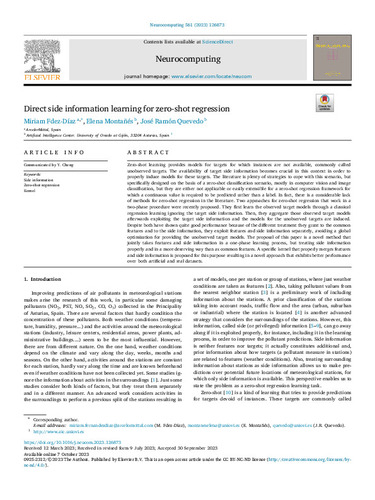Direct side information learning for zero-shot regression
Autor(es) y otros:
Palabra(s) clave:
Side information
Zero-shot regression
Kernel
Fecha de publicación:
Editorial:
Elsevier
Versión del editor:
Citación:
Resumen:
Zero-shot learning provides models for targets for which instances are not available, commonly called unobserved targets. The availability of target side information becomes crucial in this context in order to properly induce models for these targets. The literature is plenty of strategies to cope with this scenario, but specifically designed on the basis of a zero-shot classification scenario, mostly in computer vision and image classification, but they are either not applicable or easily extensible for a zero-shot regression framework for which a continuous value is required to be predicted rather than a label. In fact, there is a considerable lack of methods for zero-shot regression in the literature. Two approaches for zero-shot regression that work in a two-phase procedure were recently proposed. They first learn the observed target models through a classical regression learning ignoring the target side information. Then, they aggregate those observed target models afterwards exploiting the target side information and the models for the unobserved targets are induced. Despite both have shown quite good performance because of the different treatment they grant to the common features and to the side information, they exploit features and side information separately, avoiding a global optimization for providing the unobserved target models. The proposal of this paper is a novel method that jointly takes features and side information in a one-phase learning process, but treating side information properly and in a more deserving way than as common features. A specific kernel that properly merges features and side information is proposed for this purpose resulting in a novel approach that exhibits better performance over both artificial and real datasets.
Zero-shot learning provides models for targets for which instances are not available, commonly called unobserved targets. The availability of target side information becomes crucial in this context in order to properly induce models for these targets. The literature is plenty of strategies to cope with this scenario, but specifically designed on the basis of a zero-shot classification scenario, mostly in computer vision and image classification, but they are either not applicable or easily extensible for a zero-shot regression framework for which a continuous value is required to be predicted rather than a label. In fact, there is a considerable lack of methods for zero-shot regression in the literature. Two approaches for zero-shot regression that work in a two-phase procedure were recently proposed. They first learn the observed target models through a classical regression learning ignoring the target side information. Then, they aggregate those observed target models afterwards exploiting the target side information and the models for the unobserved targets are induced. Despite both have shown quite good performance because of the different treatment they grant to the common features and to the side information, they exploit features and side information separately, avoiding a global optimization for providing the unobserved target models. The proposal of this paper is a novel method that jointly takes features and side information in a one-phase learning process, but treating side information properly and in a more deserving way than as common features. A specific kernel that properly merges features and side information is proposed for this purpose resulting in a novel approach that exhibits better performance over both artificial and real datasets.
ISSN:
Notas Locales:
OA ATUO23
Patrocinado por:
This research has been partially supported by the Spanish Ministry of Science and Innovation through the grant PID2019-110742RB-I00.
Colecciones
- Artículos [36339]
- Informática [805]
- Investigaciones y Documentos OpenAIRE [7989]
Ficheros en el ítem





